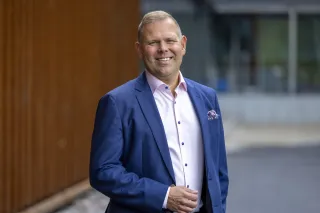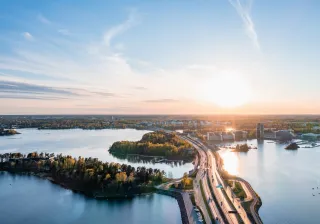Technologies drive sustainable growth by accelerating R&D and by opening business opportunities and fostering societal renewal.
Finland has set a national target to accelerate research and innovation activities to achieve sustainable growth. As investments become more substantial, it is important that we create understanding and assess how innovations are actually created. And how does human capital produce sustainable new business and wellbeing? With this opening line, we want to cheer ourselves and all innovation actors to develop the impact of research and societal value creation.
The global green transition has been described as “An all-time jackpot”, an opportunity of up to EUR 100 billion, to Finland (Climate Leadership Coalition & Boston Consulting Group, in Finnish).
The ability of our industry to invest in technological breakthroughs that create radical change is at the heart of the whole of Finland's future. VTT bears the responsibility for creating an innovation environment in which we have the ability to see opportunities for radical change and competence to develop unique science-based solutions for implementing change. We strive for a society where top science turns smoothly into commercial and social wellbeing and, thus, a better future for new generations around the world.
Impacts of research and innovation activities created at many different levels
Considering the impacts of research, it is easy to notice the current top companies and breakthroughs happening right now.
Take two fresh examples in quantum technology and textiles. The quantum computer currently humming away at VTT's Otaniemi location is easy to highlight in the headlines, as there are not many places in the world where we have come this far. Similarly, it is easy to see value in Infinited Fiber Company, forecasting infinite life to textile fibres, planning an investment of EUR 400 million in Kemi. Or that Spinnova, listed in the Helsinki Stock Exchange, mimicking spider webs with cellulose fibre, has been named one of the world's best innovations in Time magazine. These VTT-driven companies collaborate with giant brands like Adidas, Bestseller, H&M and Patagonia.
However, it is harder to see how decades of work leading to this point has produced new top clusters, international networks, research infrastructure and expertise at the global level in Finland.
For this reason, I will attempt to outline VTT's impact at two different levels. The first describes how cooperation with VTT directly affects our customers. The other level that is more difficult to measure describes our wider impacts on society and the innovation environment. At this level, VTT has an indirect but possibly even more fundamental impact on how easy it is to invest in renewal in Finland.
In the big picture, our impact can be summarised in the following six perspectives:
CUSTOMERS – How cooperation with VTT affects our customers directly:
- For their innovation work, our customers get unique expertise and the latest technologies
- 93% of customers say that their knowledge base has improved during the joint project
- 20% of VTT publications have been produced in cooperation with companies
- Our customers' RDI projects accelerate and their results become more scalable
- 62% of customers felt that the project accelerated their R&D activities
- 72% of new product or service development projects were successful
- New international business opportunities open up for our customers
- 60% of customers said the project brought new business opportunities
- 51% feel that cooperation has improved competitiveness and 46% feel that it has improved international networks
SOCIETY – This is how VTT strengthens the creation of wider value in society:
- Sustainable renewal in business
- 75% of customers feel that cooperation contributed to achieving the customer's sustainability goals
- Working with us often leads to new investments (21%) and recruitments (18% )
- Creating new international deep technology growth companies
- 50+ start-ups originating from VTT
- 8.2% of the funding collected by the entire Finnish start-up field (2013-2022) for VTT-based companies
- The number of experts and competences in Finland is increasing
- The industry and other actors in society recruit approximately 100-150 top professionals from VTT annually
- VTT employs 700 doctors and licentiates, 13% of VTT employees are international
Source: VTT's Customer Impact Study 2022
We influence the world by solving global challenges
We want to focus all our expertise and enthusiasm on the systemic and technological challenges where we can achieve maximum impact. They are currently as follows:
- Carbon neutrality
- Productivity leap
- Societal resilience
- Quantum technology
- Digital modelling and performance of materials
- Superior digital systems
- Synthetic biology
- Energy technologies
What questions does the company tackle when they need to invest in a radical change?
In its most recent country report on Finland (Economic survey of Finland, 2022), the OECD explicitly highlighted that Finland's weak economic and productivity development is caused by the weakening of our innovation system and companies investing too little.
What are the bottlenecks and uncertainties that hamper the creation of innovations that would significantly renew business? What kind of questions should the company tackle when considering whether it is worth investing in creating something new?
The investment decision may be preceded by at least the following questions:
- Can we find the right ideas to transform business?
Innovations require encountering different ideas and competences. Ideas leading to significant innovations are usually the result of long-term cooperation and a broad competence base. - Do we have access to expertise that is wide and deep enough? The development of a globally competitive solution requires unique expertise, which emerges from decades of matured knowledge and an expanding group of experts.
- Do we have the strongest hand? Time and money should be directed to ideas and solutions that are likely to offer the greatest impacts and, on the other hand, are most likely to break through commercially. Ideas should be validated and tested.
- Is the idea future-proof? The idea of combining a challenge and a solution is of high quality only if it corresponds to our understanding of responsibility and functionality also in years to come. We must learn to assess the impacts of the idea more comprehensively.
- Will we be able to enter the market on time in relation to the investment? Even a significant RDI investment will ultimately be profitable if it leads the way towards the scalable markets. Time is also money in RDI work. A good partner accelerates development.
It is easy to give examples of how VTT has a positive impact on each bottleneck presented above, but measuring our overall impact is another matter. In addition to the continuous development of customer work, we would like to ask ourselves: how could we assess our overall impact on the ability of business to create radical change? What is ultimately the most essential and how could it be assessed?
Research and innovation activities must be accelerated in order to achieve sustainable growth
The Finnish Parliament passed a law on the financing of state research and development (R&D) activities in Finland in 2024–2030. This is exceptional because, as a rule, such central government expenditure is decided in the annual budget. The act requires that government R&D funding be increased by approximately EUR 260 million each year until 2030.
Underpinning the Act is the parliamentary consensus that research, development and innovation (RDI) activities must be accelerated in order to renew the economy and society, improve productivity, make renewal sustainable and invite investments in Finland.
The RDI act targets precisely what Finland should, indeed, do. Now, we must consider how the increases in RDI funding should be targeted so that they actually generate innovations that promote sustainable growth and lead to renewal and better productivity.
Each research and innovation actor should now pose this question to themselves as well: What are the impacts of our research and development work? How will the new information we create become tangible and valuable to society?




